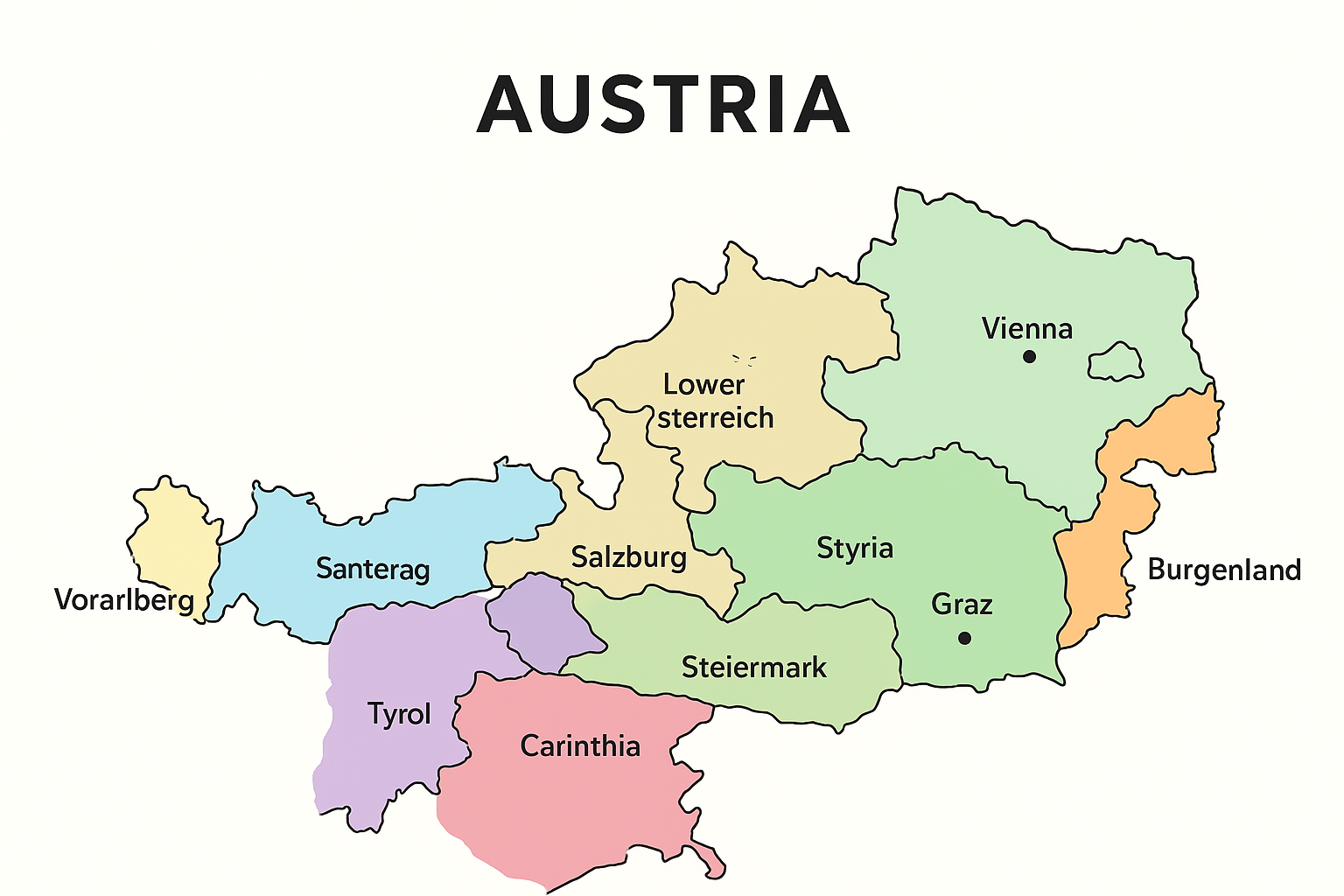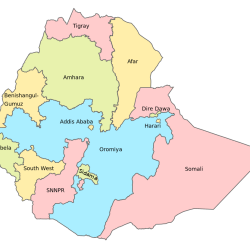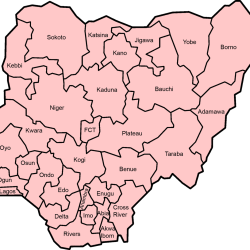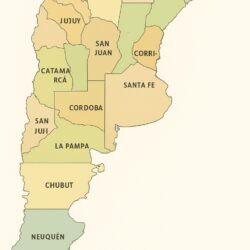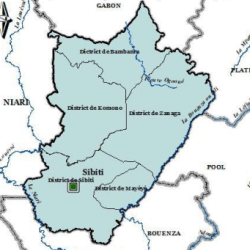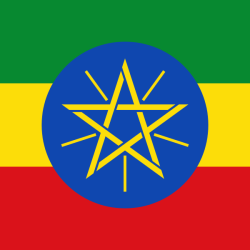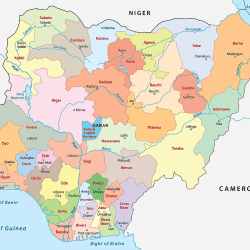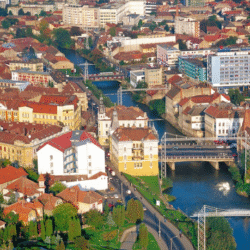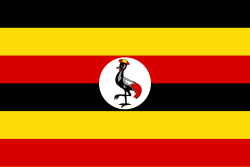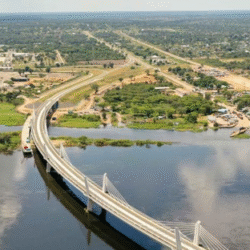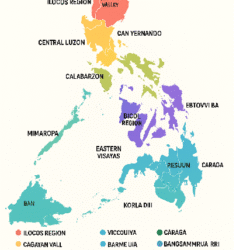Austria’s administrative divisions comprises nine federal states, capitals, population, and GDP.
Why Vienna is both a city and a state.
Austria’s Administrative Divisions
Austria is a federal republic in Central Europe, and its political system is built on a structure of shared powers between the national government and regional authorities. The country is divided into nine federal states (Bundesländer), each with its own capital, government, and unique cultural identity. These federal states are further divided into districts (Bezirke), municipalities (Gemeinden), and in some cases, statutory cities (Statutarstädte), which have the powers of both a municipality and a district.
Vienna stands out as Austria’s capital city and at the same time a federal state, making it unique among the nine regions. This administrative setup ensures balance between national unity and regional autonomy.
List of Austria’s 9 federal states (Bundesländer)
- Burgenland – Capital: Eisenstadt
- Carinthia (Kärnten) – Capital: Klagenfurt
- Lower Austria (Niederösterreich) – Capital: Sankt Pölten
- Upper Austria (Oberösterreich) – Capital: Linz
- Salzburg – Capital: Salzburg
- Styria (Steiermark) – Capital: Graz
- Tyrol (Tirol) – Capital: Innsbruck
- Vorarlberg – Capital: Bregenz
- Vienna (Wien) – Capital: Vienna (also a federal state)
Austria as a Federal Republic
What Makes Austria a Federal State?
Austria’s constitution guarantees that each federal state has its own parliament and government, though many powers are delegated to the national level. This federal system ensures that cultural diversity and regional priorities are respected while maintaining a strong central government.
The Role of Federal States in Governance
Federal states are responsible for certain areas of lawmaking and administration such as education, public health, local policing, and cultural matters. Districts and municipalities manage day-to-day governance, including infrastructure and public services.
The Nine Federal States of Austria
Burgenland – Austria’s Easternmost State
- Capital: Eisenstadt
- Area: 3,965 sq km
- Population (2017): 291,942
- GDP (2022): €10.45 billion
- GDP per capita: €34,900
Known for its vineyards, lakes, and proximity to Hungary, Burgenland is Austria’s least populated state but has a growing reputation for renewable energy and tourism.
Carinthia – Land of Lakes and Mountains
- Capital: Klagenfurt
- Area: 9,536 sq km
- Population (2017): 561,077
- GDP (2022): €24.75 billion
- GDP per capita: €43,600
Carinthia is famous for its alpine scenery and crystal-clear lakes, making it a popular holiday region for both winter and summer tourism.
Lower Austria – The Largest Federal State
- Capital: Sankt Pölten
- Area: 19,178 sq km
- Population (2017): 1,665,753
- GDP (2022): €71.75 billion
- GDP per capita: €41,900
Lower Austria surrounds Vienna and is the largest Austrian state by area. It is a major hub for agriculture, wine production, and industry.
Upper Austria – Industrial and Economic Powerhouse
- Capital: Linz
- Area: 11,982 sq km
- Population (2017): 1,465,045
- GDP (2022): €76.78 billion
- GDP per capita: €50,700
Upper Austria is one of the wealthiest and most industrialized regions, hosting strong manufacturing and technology sectors.
Salzburg – Land of Mozart and the Alps
- Capital: Salzburg
- Area: 7,154 sq km
- Population (2017): 549,263
- GDP (2022): €33.33 billion
- GDP per capita: €58,900
World-renowned as the birthplace of Mozart and home to The Sound of Music, Salzburg combines cultural heritage with breathtaking alpine landscapes.
Styria – The Green Heart of Austria
- Capital: Graz
- Area: 16,401 sq km
- Population (2017): 1,237,298
- GDP (2022): €56.15 billion
- GDP per capita: €44,600
Styria is Austria’s second-largest state and is often called the “green heart” due to its forests, vineyards, and focus on sustainability.
Tyrol – Alpine Paradise and Tourism Hub
- Capital: Innsbruck
- Area: 12,648 sq km
- Population (2017): 746,153
- GDP (2022): €39.32 billion
- GDP per capita: €51,200
Tyrol is dominated by the Alps and is internationally famous for skiing, mountaineering, and winter sports. Innsbruck has twice hosted the Winter Olympics.
Vorarlberg – Westernmost and Culturally Distinct
- Capital: Bregenz
- Area: 2,601 sq km
- Population (2017): 388,752
- GDP (2022): €23.59 billion
- GDP per capita: €58,300
Vorarlberg borders Switzerland, Germany, and Liechtenstein. Its culture has strong Alemannic influences, distinct from the rest of Austria.
Vienna – Capital City and Federal State
- Capital: Vienna (same as state)
- Area: 415 sq km
- Population (2017): 1,867,582
- GDP (2022): €110.99 billion
- GDP per capita: €56,600
Vienna is both the national capital and a federal state. It is the smallest in area but the largest by population and GDP. Vienna consistently ranks as one of the most livable cities in the world.
Comparative Table of Austria’s Federal States
| Federal State | Capital | Area (sq km) | Population (2017) | GDP (€bn, 2022) | GDP per capita (€) |
|---|---|---|---|---|---|
| Burgenland | Eisenstadt | 3,965 | 291,942 | 10.45 | 34,900 |
| Carinthia | Klagenfurt | 9,536 | 561,077 | 24.75 | 43,600 |
| Lower Austria | Sankt Pölten | 19,178 | 1,665,753 | 71.75 | 41,900 |
| Upper Austria | Linz | 11,982 | 1,465,045 | 76.78 | 50,700 |
| Salzburg | Salzburg | 7,154 | 549,263 | 33.33 | 58,900 |
| Styria | Graz | 16,401 | 1,237,298 | 56.15 | 44,600 |
| Tyrol | Innsbruck | 12,648 | 746,153 | 39.32 | 51,200 |
| Vorarlberg | Bregenz | 2,601 | 388,752 | 23.59 | 58,300 |
| Vienna | Vienna | 415 | 1,867,582 | 110.99 | 56,600 |
1. How many federal states does Austria have?
Austria has nine federal states (Bundesländer).
2. Which is the largest state in Austria by area?
Lower Austria is the largest state, covering 19,178 sq km.
3. Which Austrian state has the highest GDP per capita?
Salzburg and Vorarlberg lead with GDP per capita exceeding €58,000.
4. Is Vienna a city or a state?
Vienna is both a city and a federal state, making it unique in Austria.
5. What is the smallest Austrian state?
Vienna is the smallest by area, covering only 415 sq km.
6. Do Austrian states have their own governments?
Yes, each federal state has its own parliament and government, though many decisions are coordinated with the national government.
Austria’s administrative divisions highlight the balance between unity and diversity. Each of the nine federal states contributes uniquely to the nation’s cultural richness, economic growth, and political stability. From Vienna’s global influence to Tyrol’s alpine traditions, Austria’s federal system ensures that regional identities remain strong while working together under a national framework.
